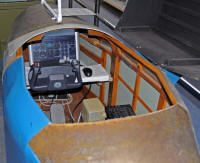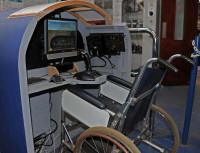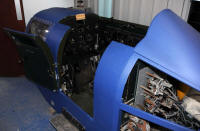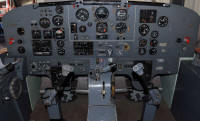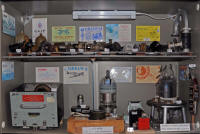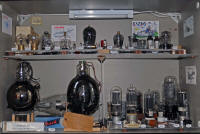
Flying Training AreaLink Trainers and Flying TrainingThe principle of providing flying training in an aircraft without actually taking off was created early in the last century. Examples at this time were the Saunders Teacher, a modified aeroplane mounted on a universal joint linked tot he ground, and the Italian Gabardini Company. The idea of using a captive aeroplane for elementary training, or for amusement, was patented in Britain by Eardley Billing in 1910. Other examples, progressively more complicated in construction and realism, followed over the years. In the U.S., Edwin Link gained his early engineering experience with his father's firm, The Link Piano and Organ Company, of Binghampton, New York. His first patent was granted for an improvement in the mechanism of player pianos! The flight trainer was developed in the period of 1927-29 in the basement of the Link factory and he made use of the familiar vacuum/pneumatic mechanisms from the family business. The first trainer, advertised as 'An effective Aeronautical Training Aid - a novel, profitable amusement device' - was described in a patent filed in 1930. Pitch, roll and yaw movements were initiated in the same manner as in its predecessors, but vacuum/pneumatic bellows were used for actuation. Vacuum was also used as an analogue computing medium for the instruments. The device was not regarded as a wise investment by others at that point, nor seen to meet a training need. By now, a serious competitor was also on the scene in the simulator built by HA Roeder. A need certainly did exist in instrument training, however, so Edwin Link fitted cockpit instruments as standard equipment to his design and blind flying training was started by the Links at their flying school in the early 1930s. The importance of this training was soon recognised, notably by the U.S. Army Air Corps, when they took on responsibility for Air Mail delivery. This gave Link Trainers a great reputation so increasing sales. The Model C followed in 1936, able to rotate through 360 degrees, which allowed for a magnetic compass to be installed, while the various instruments were operated either mechanically or by vacuum. With further refinements along the way, the Link Trainer became a simple form of analogue computer, fitted with a full set of instruments to guide the pupil on an imaginary flight. The simulated course is automatically recorded and traced by the three-wheeled course plotter (the self-propelled and steerable "crab") across paper, or a map on the instructor's desk. A duplicated instrument panel is also present, electronically harmonised with those in the Trainer's cockpit. This miniature aeroplane is pivoted on a universal joint mounted on an octagonal turntable, which in turn is free to rotate in azimuth on a square base. Between the fuselage and the turntable are four supporting bellows, which are inflated or deflated by a vacuum turbine. Its valves are operated as the pupil moves the control column, and realistically recreates most of the sensations and "feel" of flying. Both calm and rough-air flying conditions can be created by the instructor. The Trainer will also initiate stall when recorded airspeed and attitude fall outside pre-determined limits. It then goes into a very realistic spin, with the instruments performing normally for such conditions. A cross-country "flight" of up to 200 miles is possible, during which the instructor is able to confront the pupil with most of the difficulties that can occur during a genuine flight, Link Trainers were also sold to France and Germany - a Luftwaffe bomber pilot of 1940 had spent 50 hours in a Link Trainer! The Link Trainer type D4 of 1950 is also designed and equipped to provide thorough instruction in the use of radio signals, radio beams and radio compass. Both the Lorenz Landing System or SBA and SCS51 precursor of ILS for blind landings in fog are simulated. Modern-day computerised flight simulators are much more sophisticated and very realistic - and also expensive. In its time, however, the Link Trainer was at the forefront of flight technology, saving many lives... and actual aeroplanes. We have four examples of Link Trainers, although two of them are not operational. Whilst thousands existed in the UK before, during and after World War ll, they are now quite rare - even more so in working order. A small Museum team, led by member Ray Kidd, has devoted considerable effort over a number of years to their re-assembly and restoration. Regular work is required to improve and maintain them, and spare components are always being sought. In 1937, the first Link Trainers were delivered to the RAF and an airline company, American Airlines. These were the Model C-2 in the US and D for the UK and were generic trainers. The US Army Navy Trainer Model 18 (A-NT 18) of 1940/1 was designed to represent the AT-6/SNJ/Harvard aircraft. The newest Link Trainer we have is over 50 years old and therefore serviceability can be a problem. Please check before visiting if you wish for close access or to see a trainer operating. Because of difficult access, health and safety and insurance reasons we cannot let the general public operate the trainers without qualified supervision. Sometimes a fit and agile enthusiast or veteran may get the opportunity of a test flight. We also have a Redifon 101 procedures trainer based on the Jet Provost from 1970. Although not operational it provides a realistic cockpit for school visits and event days. Our Exhibits:SupportWe have some manuals and spare components but could always find room for more. We also try to give assistance to other Link owners, where possible, and the team can be contacted through the Museum’s main email address. We have had support from Link Spares in the USA where units are common to UK and USA. The D4 resembles the American “Basic Instrument Trainer 45 or 1-CA-1 in some ways. Other exhibits in the areaModelsThe area has a large collection of models of Flying Training aircraft. GunsightsA large collection of gunsights from the 1930`s to the 1980`s with some working, this is currently being reworked so none of the sights are currently working, also many labels are not in place. Navigation and Radio NavigationA large display of navigation and blind landing equipment from 1920's to current day. An intranet site (only available within the museum) gives details on the equipment on display, we aim to provide this additoinal information on this site sometime soon. |
|||||||||||
|
